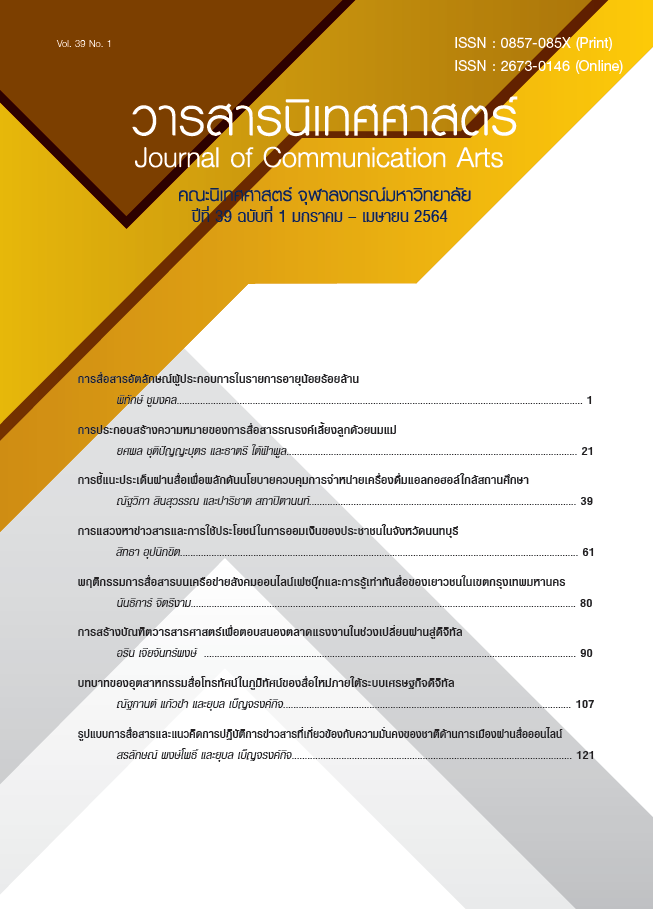Television Industry and Its Role in the New Media Landscape under the System of Digital Economy
Main Article Content
Abstract
This research is aimed to study changes in the television industry in Thailand under the digital economy system, to explore the adaptation of the television industry in Thailand in the new media landscape, to examine the roles of television in the new media landscape, and to investigate viewers’ perspectives on the roles and adaptation of television in the new media landscape. The research is a mixed-methods study. Documentary research and content analysis, including in-depth interviews and survey questionnaires. From the study, it was found that technological factors have changed the current situation of the television industry enormously. All TV stations have adapted their broadcasting and management explicitly. The content is more individualized to suitable for and attract viewers. Communication channels have been modified towards digitalization increasingly. All changes were affected by viewers’ changing behaviors. Regarding the adaptation of TV organizations in the digital economy system, it was found that they changed in four dimensions: organizational structure, communication channels, genres in content presentation, and content. It was found that nowadays televisions have to learn about their viewers primarily. The most important thing TV channels should concern is the content. Besides, it was found that television still plays the role of an opinion leader. As for viewers’ TV exposure behaviors, most of them viewed TV via YouTube the most, and the viewing device used the most was mobile phones because of its portability and because viewers could view TV programs everywhere at any time. Most samples watched TV for entertainment and relaxation, while they expected from their viewing and expected from the functioning of the TV for society as a whole was to obtain amusement, pleasure, entertainment, and emotional support.
Article Details
References
กระทรวงดิจิทัลเพื่อเศรษฐกิจและสังคม. (2559). เศรษฐกิจและสังคมดิจิทัล (Digital Economy). วันที่เข้าถึงข้อมูล 10 พฤศจิกายน 2560 แหล่งที่มา http://www.mdes.go.th/view/1/Digital%20Economy
กาญจนา แก้วเทพ และสมสุข หินวิมาน. (2553). สายธารนักคิดทฤษฎีเศรษฐศาสตร์การเมืองกับสื่อสารศึกษา. กรุงเทพมหานคร: ภาพพิมพ์.
กาญจนา แก้วเทพ. (2556). คู่มือสื่อใหม่ศึกษา. พิมพ์ครั้งที่ 2. กรุงเทพมหานคร: ภาพพิมพ์.
กิตติ กันภัย. (2556). การวิเคราะห์ผู้รับสารสื่อมวลชน. กรุงเทพมหานคร: เหรียญบุญการพิมพ์ (1998).
ชัยยงค์ พรหมวงศ์ และ นิคม ทาแดง, (2530). เอกสารการสอนชุดวิชาความรู้เบื้องต้นเกี่ยวกับวิทยุโทรทัศน์. นนทบุรี: สำนักพิมพ์มหาวิทยาลัยสุโขทัยธรรมาธิราช.
ฐิตินัน บ. คอมมอน. (2556). บทบาทของสื่อใหม่ในการสร้างค่านิยมทางสังคมและอัตลักษณ์ของเยาวชนไทยในเขตกรุงเทพมหานคร. กรุงเทพมหานคร: ศูนย์วิจัยมหาวิทยาลัยธุรกิจบัณฑิตย์.
ฐิตินัน บ. คอมมอน. (2559). การบริหารจัดการสื่อโทรทัศน์ในยุคดิจิทัลหลอมรวม. กรุงเทพมหานคร: ศูนย์วิจัยมหาวิทยาลัยธุรกิจบัณฑิตย์.
ณิชชา วัชระชยะกูร. (2559). การปรับตัวของนิตยสาร a day ในยุคดิจิทัล.วิทยานิพนธ์ปริญญามหาบัณฑิต มหาวิทยาลัยธรรมศาสตร์.
ธาม เชื้อสถาปนาศิริ. (2557). เด็กเรียนรู้อย่างไรในยุคสื่อหลอมรวม. วันที่เข้าถึงข้อมูล 10 พฤศจิกายน 2560 แหล่งที่มา http://www.isranews.org/thaireform-news-mass-comm/item/29184- media07.html
ธาม เชื้อสถาปนาศิริ. (2557ข.) “USER-GENERATED CONTENT”: ยุคสื่อของผู้ใช้. วันที่เข้าถึงข้อมูล 10 พฤศจิกายน 2560 แหล่งที่มา https://positioningmag.com/58244
เพ็ญพักตร์ เตียวสมบูรณ์กิจ. (2557). ความรู้เท่าทันสื่อของผู้ใช้สื่อโทรทัศน์ไทยภายใต้ภูมิทัศน์สื่อโทรทัศน์ที่เปลี่ยนไป. วิทยานิพนธ์ปริญญาดุษฎีบัณฑิต จุฬาลงกรณ์มหาวิทยาลัย.
ศุภศิลป์ กุลจิตต์เจือวงศ์. (2557). การปรับตัวของรายการโทรทัศน์กับพฤติกรรมการเปิดรับสื่อหลายหน้าจอ. วารสารมนุษย์สังคมศาสตร์ มหาวิทยาลัยทักษิณ. 9(ตุลาคม), 103-120.
สกุลศรี ศรีสารคาม. (2557). สื่อโทรทัศน์ในยุคดิจิทัล. กรุงเทพมหานคร: ภาพพิมพ์.
สมสุข หินวิมาน และคณะ. (2557). ความรู้เบื้องต้นทางวิทยุและโทรทัศน์. กรุงเทพมหานคร: สำนักพิมพ์มหาวิทยาลัยธรรมศาสตร์.
สมสุข หินวิมาน และคณะ. (2558). ธุรกิจสื่อสารมวลชน. กรุงเทพมหานคร: สำนักพิมพ์มหาวิทยาลัยธรรมศาสตร์.
สำนักนโยบายและวิชาการกระจายเสียงและโทรทัศน์ สำนักงานคณะกรรมการกิจการกระจายเสียง กิจการโทรทัศน์ และกิจการโทรคมนาคมแห่งชาติ. (2561). รายงานการวิเคราะห์สภาพอุตสาหกรรมและตลาดกิจการโทรทัศน์ไทย. กรุงเทพมหานคร: สำนักงานคณะกรรมการกิจการกระจายเสียง กิจการโทรทัศน์ และกิจการโทรคมนาคมแห่งชาติ.
สำนักนโยบายและวิชาการกระจายเสียงและโทรทัศน์ สำนักงานคณะกรรมการกิจการกระจายเสียง กิจการโทรทัศน์ และกิจการโทรคมนาคมแห่งชาติ. (2562). 5 ปี บนเส้นทางทีวีดิจิตอล: บทเรียน และ การเปลี่ยนแปลง. กรุงเทพมหานคร: สำนักงานคณะกรรมการกิจการกระจายเสียง กิจการโทรทัศน์ และกิจการโทรคมนาคมแห่งชาติ.
สำนักงานคณะกรรมการพัฒนาการเศรษฐกิจและสังคมแห่งชาติ. ม.ป.ป. สรุปสาระสำคัญ แผนพัฒนาเศรษฐกิจและสังคมแห่งชาติ ฉบับที่สิบสอง พ.ศ. 2560-2564. กรุงเทพมหานคร: สำนักงานคณะกรรมการพัฒนาการเศรษฐกิจและสังคมแห่งชาติ. สำนักนายกรัฐมนตรี.
สุภาณี คชพันธ์สมโภชน์. (2558). การปรับตัวของสื่อมวลชนในยุคหลอมรวมสื่อที่มีผลต่อกองบรรณาธิการ. วิทยานิพนธ์ปริญญามหาบัณฑิต มหาวิทยาลัยรามคำแหง.
อนุสรา อนุวงค์. (2558). Digital Economy สิ่งนี้สำคัญไฉน. ศูนย์บริการวิชาการเศรษฐศาสตร์ คณะเศรษฐศาสตร์ มหาวิทยาลัยธรรมศาสตร์.
Albarren A. B. (2006). Management of Electronic Media. (3rd ed.). Belmont: Thomas/Wadsworth.
Brsndtzaeg J.H. and P. B. (2007). Pattern of Media Usage and The Non- Professional Users. Paper presented at The “Supporting Non-Professional Users in The New Media Landscape”. San Jose. USA.
Buckingham D. (2005). The Media Literacy of Children and Young People. A review of the research literature on behalf of Ofcom.
Day, G. S., & Schoemaker, P. J. H. (2000). Avoiding the pitfalls of emerging technologies. California Management Review. 42(2). 8–33.
Jan Van Dijk. (2006). The Network Society. (Second Edition ed.) London: Sage Publications.
K.R. Logan. (2010). Understanding New Media: Extending Marshall McLuhan. New York: Peter Lang Publishing, Inc.
Marcel Danesi. (2002). Understanding Media Semiotics. London: Arnold.
McQuail D. (2005). McQuail’s Mass Communication Theory. 5th ed. London: Sage Publications.
OECD (2001), Understanding the Digital Divide, OECD Digital Economy Papers, No. 49, OECD Publishing, Paris.
Peter Pringle & Michael F Starr. (2006). Electronic Media Management. London: Routledge.
Tse, Y.-K. (2016). Television’s changing role in social togetherness in the personalized online consumption of foreign TV. New Media & Society, 18(8), 1547–1562.


